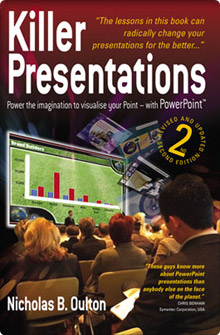
Managing the Details Without Losing Your Key Messages
I recently delivered the Killer Presentations course to a group of financial service industry sales professionals in New York City. An important learning in this training is to trim the information in your presentation to include only the most relavent data you want your audience to remember. A few days later, I got the following question from an attendee about all the other information that needs to be delivered eventually:
If the sales presentation delivers 4 or 5 key points you want the audience to know, what’s the best way to communicate the much weightier technical detail that lies behind those key points?
The first question is do you really need to get into technical detail in the presentation? When I am teaching kids to sail, I need them to know that to turn the boat, they must move the tiller in the opposite direction. Do they need to understand the mathematics of how the rudder creates turning momentum on the stern of the boat? No.
How much detail does the audience need to understand your value proposition?
People often include too much technical detail in their presentations. I’m guilty of it. When we deliver the course it’s often hard to judge how much of the science and research behind the Killer Presentations Philosophy is appropriate. Some sales people don’t care how or why it works, as long as they close more business using the techniques. Others need more proof than my recommendation to change the habits they’ve developed over 20 years of presenting.
Determining how much to deliver is difficult and dynamic based on the audience, their level of understanding of your industry/product/service; the number or presentations they’ve already seen; and the amount of time you’ve spent educating them in advance. Audience size matters as well, the bigger the group, the greater the chance of “pockets of interest” that drive information flow to minority groups in the audience. Meaning, time consuming questions that are only of interest to one or two people in a big team. You just lost the majority of your audience explaining how the sausage is made.
Over-prepare, share as needed, rinse, repeat.
My advice is to develop more material than you need, then take your cue from the audience as to how much to present. We preach to the students in our Killer Presentations course that they must refresh their recall on important information one day, one week and one month after hearing it to ensure it stays in their memory.
If you can get your prospects to review the material (repetition) and think about something new but associated (elaboration), we know recall and application increase. In which case having more detail in the follow up communication is extremely useful.
It also helps to provide that content in a variety of media, including PDFs, videos, podcasts—whatever forms your audience will absorb best. Also consider the impact of the information flow. People learn more if they can work at their own pace and journey through the material at will. Self directed learning requires more content than a simple linear information flow.
In summary:
- Give them what they need
- Give them control over the quantity and depth
- Give them multi modal information
- Sequence delivery over time to improve recall
